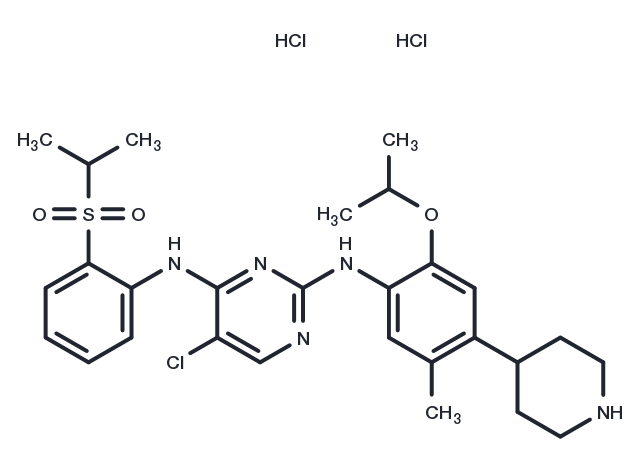Powder: -20°C for 3 years | In solvent: -80°C for 1 year


Ceritinib dihydrochloride (LDK378 dihydrochloride) is a selective, orally bioavailable and ATP-competitive inhibitor of ALK tyrosine kinase(IC50 of 200 pM), and also inhibits IGF-1R, InsR, and STK22D (IC50 values of 8, 7, and 23 nM, respectively), shows great antitumor potency

| Pack Size | Availability | Price/USD | Quantity |
|---|---|---|---|
| 5 mg | In stock | $ 43.00 | |
| 10 mg | In stock | $ 58.00 | |
| 25 mg | In stock | $ 71.00 | |
| 50 mg | In stock | $ 85.00 | |
| 100 mg | In stock | $ 126.00 | |
| 1 mL * 10 mM (in DMSO) | In stock | $ 60.00 |


| Description | Ceritinib dihydrochloride (LDK378 dihydrochloride) is a selective, orally bioavailable and ATP-competitive inhibitor of ALK tyrosine kinase(IC50 of 200 pM), and also inhibits IGF-1R, InsR, and STK22D (IC50 values of 8, 7, and 23 nM, respectively), shows great antitumor potency |
| Targets&IC50 | ALK:0.2 nM , INSR:7 nM , STK22D:23 nM, IGF-1R:8 nM |
| In vitro | In vitro experiments also showed that lipopolysaccharide (LPS)-induced migration of MDSCs was similarly owing to the activation of GRK2 and upregulation of CCR2 by LPS, whereas the treatment with LDK378 partially blocked the LPS-induced phosphorylation of p38 and GRK2 and decreased the expression of CCR2 on the cell surface, therefore leading to the suppression of MDSC migration[1]. |
| In vivo | LDK378 significantly improved the survival of CLP-induced polymicrobial septic mice, which was paralleled by reduced organ injury, decreased release of inflammatory cytokines and decreased recruitment of MDSCs to the spleen.?Importantly, LDK378 inhibited the migration of MDSCs to the spleen by blocking the CLP-mediated upregulation of CC chemokine receptor 2 (CCR2), a chemokine receptor critical for the recruitment of MDSCs.?Mechanistically, LDK378 treatment blocked the CLP-induced CCR2 upregulation of MDSCs via partially inhibiting the phosphorylation of p38 and G-protein-coupled receptor kinase-2 (GRK2) in bone marrow MDSCs of septic mice[1]. |
| Synonyms | LDK378 dihydrochloride |
| Molecular Weight | 631.06 |
| Formula | C28H38Cl3N5O3S |
| CAS No. | 1380575-43-8 |
Powder: -20°C for 3 years | In solvent: -80°C for 1 year
H2O: 5 mg/mL (7.92 mM), Sonication is recommended.
DMSO: 95 mg/mL (150.54 mM), Sonication is recommended.
You can also refer to dose conversion for different animals. More
bottom
Please see Inhibitor Handling Instructions for more frequently ask questions. Topics include: how to prepare stock solutions, how to store products, and cautions on cell-based assays & animal experiments, etc.
Ceritinib dihydrochloride 1380575-43-8 Angiogenesis Tyrosine Kinase/Adaptors IGF-1R ALK inhibit Inhibitor ALK tyrosine kinase receptor LDK378 LDK 378 Anaplastic lymphoma kinase (ALK) LDK378 Dihydrochloride Cluster of differentiation 246 Insulin Receptor LDK-378 LDK378 dihydrochloride Ceritinib Dihydrochloride Ceritinib Anaplastic lymphoma kinase CD246 LDK-378 Dihydrochloride LDK 378 Dihydrochloride inhibitor
